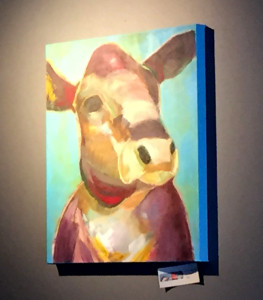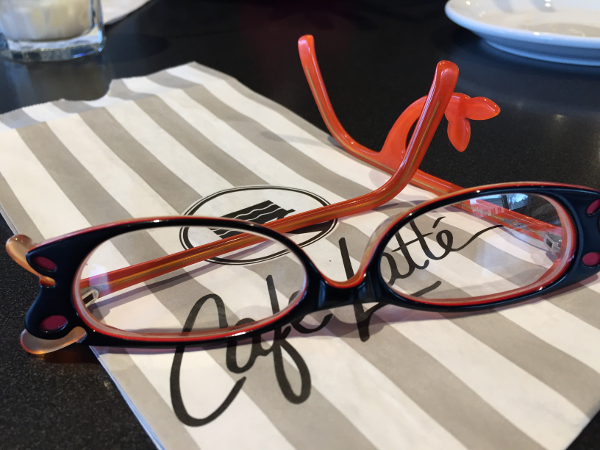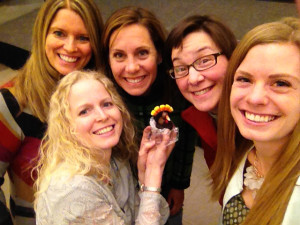Cowabunga! My last meeting with MN SCBWI Writers Mentor Trisha Speed Shaskan moo-ved me. Charming bovines surrounded us, rendering me defenseless against cheesy puns.
Oh, no!
I can’t stop!
All bull aside, I’m so thankful for Trisha’s encouragement, gently prodding me to a new level of children’s book writing. I hope my notes will encourage you, too.
ANNIHILATE THOSE DARLINGS!
Killing darlings is essential for picture books, where low word count is optimum. Darlings can be extra characters, clever twists, funny dialog, or witty phrases–any words we think we can’t live without (but can). Writers’ minds understand killing darlings, but our hearts are reluctant to sacrifice our beloved(s).
Regarding my manuscript, my critique group had already encouraged the execution of a funny old knight and some annoying songbirds, so I thought I’d whittled to its bare bones. But Trisha still  found phrases and adjectives that needed to march to the guillotine.
found phrases and adjectives that needed to march to the guillotine.
Since my picture book is bordering long, at 560 words, I needed to cut the fat. (Sorry about my grizzly metaphors.)
Could the illustrator show that “wigs, walking sticks, and wooden teeth flew” without those seven extra words?
Could the illustrator show that the environment is cramped, dark, and musty, even if I just call it a cellar?
 Could the illustrator deliver more punch?
Could the illustrator deliver more punch?
YES! YES! YES!
Killing your darlings is all about trusting the illustrator!
WORLD BUILDING
Trisha reminded me to ponder the world I’d created. Is it authentic?
For instance, my tale is set in medieval times and I needed a place for my characters to escape an impending threat. Only one of these truly fit my story:
- a cramped tunnel
- a cellar
- a dark dungeon
- the musty basement
If you picked “cellar,” I know you read the “Annihilate Those Darlings” segment. Cramped, dark, and musty can be illustrated with colors, space, and character expressions and mannerisms.
I originally chose tunnel, but after Trisha encouraged me to reconsider, it occurred to me that I wanted the next scene to flow up, not to another destination. I passed on a dungeon, because a dungeon infers imprisonment and I already had a prison in a different place. I rejected the basement, because the word “basement” originated in 1730, after the middle ages. Cellars were underground chambers–usually cramped, dark, and musty–where medievals kept perishables. Cellar was perfect.
Certainly, some time travel stories are built to interject medieval with modern themes, but mine wasn’t one of them.
Scrutinize your word choices. Are they consistent with the rules you have set?
BE PATIENT AND PERSISTENT!
I love writing stories, but I hadn’t done any querying since my early days of children’s book writing when I naïvely thought the process was easy. Now I’m embarrassed and would like a do-over. Since then, there is one bit of advice I’d like to extend to all picture book writers: BE PATIENT! Do NOT query agents and editors until two experienced critique partners and one mentor says your manuscript is perfect. And, wait–still don’t send that query until you write another manuscript and have that approved.
After three and a half years of hard work, I’ve finally received the thumbs up I need for two stories, plus I’ve accumulated almost a dozen other manuscripts in various stages of polish. But I’m far from done.
Here’s where the next stage of PERSISTENCE comes in. Finding the perfect agent or editor may be as hard as writing the perfect manuscript. Be selective and ask the right questions.
- Does she represent picture books? Editors who prefer YA? Probably not for me.
- Does my work fit his taste? Vampire seeking agents? Nada.
- Is she accepting new clients? This question should be #1.
- Does he accept authors who don’t illustrate? My list just got smaller.
- Do she have a sense of humor? You vill write and you vill like it! Nyet.
- Which publishing houses represent my favorite writers and illustrators? There are so many!
- Which publishing houses distribute my favorite books? Publishers, like people, have unique tastes.
When I showed Trisha my list of ten well-researched possibilities, she encouraged me to increase it to 30-40, and start sending three or four at a time, (each a personalized query, of course). She also advised me to consider newer agents, as well as the experienced. She reminded me that new agents are building their base and would work hard for their clients.
Back to the search engines.
In gratitude, these blog posts are my small effort to pay my mentorship experience forward, hoping you will benefit from Trisha’s wisdom as well.
On behalf of both of us, may you learn a latte’! (Lucky for you, I couldn’t think of another cow pun.)







